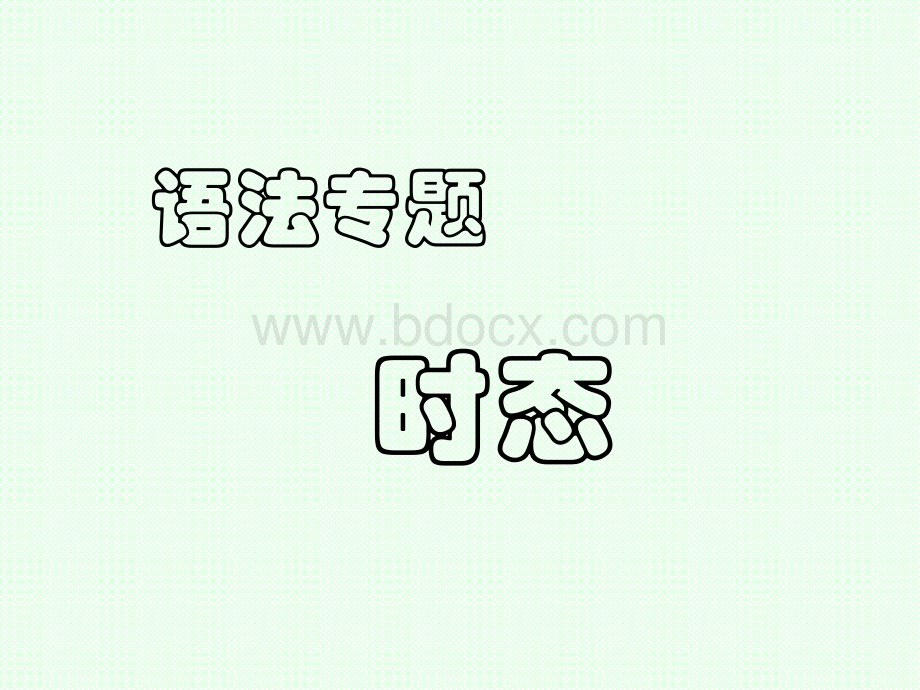高考大纲十种时态讲解PPT资料.ppt
《高考大纲十种时态讲解PPT资料.ppt》由会员分享,可在线阅读,更多相关《高考大纲十种时态讲解PPT资料.ppt(83页珍藏版)》请在冰豆网上搜索。

把be动词放于句首;
用助动词do提问,如主语为第三人称单数,则用does,同时,还原行为动词。
什么情况下用?
表示经常或习惯性的动作或存在的状态。
表示主语通常的能力、兴趣爱好、和性格特征。
表示客观的事实或真理。
表示按照时刻表或已经计划安排好的将来行为。
(只限于是go,come,leave,arrive,begin,start,takeoff,stop,be等表示开始或移动意义的词。
)在时间状语从句和条件状语从句中,主句用一般将来时(will+动词原形),从句中用一般现在时表将来。
(主将从现)(主将从现)当主语是第三人称时,谓语动词要用第三人称单数形式,加-s/es。
除此之外都用动词原形。
动词第三人称单数形式变化规则规则规则例子例子一般在词尾加一般在词尾加-s-s,(清辅音后清辅音后读读/s/s/,在浊辅音后读,在浊辅音后读/z/z/;
在在tt后读后读/ts/,/ts/,在在dd后读后读/dz/dz/。
)PlayPlayplaysplaysleaveleaveleavesleavesswimswimswimsswims以字母以字母s,x,ch,sh,os,x,ch,sh,o结尾的词结尾的词加加-es-es,读,读/iz/,/iz/,如果动词原形如果动词原形词尾已有词尾已有e,e,则只加则只加-s-s。
passpasspassespassesfixfixfixesfixesteachteachteachesteacheswishwishwisheswishesdododoesdoes以辅音字母加以辅音字母加yy结尾的词结尾的词,先变,先变yy为为i,i,再加再加-es,-es,读读/z/z/studystudystudiesstudiescarrycarrycarriescarriesflyflyfliesflies1.He_(be,am,is,are)ateacheratNo.2MiddleSchool.2.He_(have,has)classesintheafternoon.3.He_(get,gets)upathalfpastsixeverymorning.4.Healways_(come,comes)toschoolontime.5.He_(study,studies)veryhardathislesson.6.Oneandtwo_(be,is,are)three.7.Blueandyellow_(make,makes)green.8.Theearth_(move,moves)roundthesun.9.IwillgothereifI_(be,willbe,am,is,are)freetomorrow.2、一般过去时概念:
过去某个时间里发生的动作或状态;
过去习概念:
过去习惯性、经常性的动作、行为。
惯性、经常性的动作、行为。
时间状语时间状语:
ago,yesterday,thedaybeforeyesterday,lastweek(year,night,month),in1989,justnow,attheageof5,oneday,longlongago,onceuponatime,etc.基本结构:
行为动词否定形式:
was/were+not;
在行为动词前加didnt,同时还原行为动词。
一般疑问句:
was或were放于句首;
用助动词do的过去式did提问,同时还原行为动词。
谓语动词使用过去式形式,加ed,分为规则和不规则变化。
表示过去经常发生的动作,也可用“usedtodousedtodo”和“would+动词原形”。
构成规则构成规则例子一般在动词原形末尾加-ed,(在清辅音后读/t/;
在浊辅音和元音后读/d/;
在/t/,/d/后读/id/。
looklookedplayplayedworkworked结尾是e的动词在末尾加-dlikelikedlivelivedhopehoped末尾只有一个辅音字母的重读闭音节,先双写这个辅音字母,再加-edplanplannedstopstoppeddropdropped结尾是“辅音字母y”的动词,先变“y”为“i”再加-edstudystudiedworryworriedcrycried1.He_(be,was,were,been)hereamomentago.2.They_(be,was,were,been)herejustnow.3.Thescientists_(leave,leaves,leaved,left)forAmericayesterday.4.Lastweekwe_(visit,visited)theScienceMuseum.5.WhenIwasachild,Ioften_(play,played)football.6.Thestudentsranoutoftheclassroomassoonasthebell_(ring,rang,rung).3、一般将来时构成构成:
will,shall+动词原形,其中shall只用于第一人称。
begoingto+动词原形,表示主观打算,按计划,安排要发生的事情。
beto+动词原形,表示客观安排beaboutto+不定式,意为马上要做某事,正要做某事。
某些动词,可用进行时态表将来,如come,go,arrive,leave。
在时间状语从句和条件状语从句中,主句用一般将来时(will+动词原形),从句中用一般现在时表将来。
一般现在时可表示按时间表发生的将来的动作(限start,begin,arrive,end,close,leave-等表示开始或移动意义的词)时间状语时间状语:
Tomorrow,nextday(week,month,year),soon,inafewminutes,by,thedayaftertomorrow,etc.否定形式否定形式:
主语+am/is/arenotgoingtodo;
主语+will/shallnotdo+其他一般疑问句一般疑问句:
be放于句首;
will/shall提到句首。
e.g.Shewillbebackinthreedays.Shewillnotbebackinthreedays.WillShebebackinthreedays?
Theyaregoingtocleantheirclassroom.Theyarenotgoingtocleantheirclassroom.Aretheygoingtocleantheirclassroom?
1_you_adoctorwhenyougrowup?
AWill;
goingtobeBAre;
goingtobeCAre;
/DWill;
be2Idontknowifhisuncle_.Ithinkhe_ifitdoesntrain.Awillcome;
comesBwillcome;
willcomeCcomes;
comesDcomes;
willcome3Hewillbeback_afewminutes.AwithBforConDin4Whattime_wemeetatthegatetomorrow?
AwillBshallCdoDare5Hewillhaveaholidayassoonashe_theworknextweek.AfinishesBdoesntfinishCwillfinishDwontfinish6There_someshowersthisafternoon.AwillbeBwillhaveCisgoingtobeDaregoingtohave7It_mybrothersbirthdaytomorrow.She_aparty.Aisgoingtobe;
willhaveBwillbe;
ishavingCwillbe;
isgoingtohaveDwillhave;
isgoingtobe8LiMingis10yearsoldnow,nextyearhe_11.AisBisgoingtobeCwillbeDwilltobe4、过去将来时构成:
构成:
(would+动词原形,或将来时的其它过去构成形式wasgoingtodo)表示以过去某一时间为参照,在过去看将要发生的动作或存在的状态。
在宾语从句及间接引语中,时态呼应,经常会用到过去将来时。
如Ithoughtitwasgoingtobefun.时间状语时间状语:
-soon/thenextday-that-clause(名词性从句或上下文中-)1.ItoldmyfriendthatI_(should/wouldarrive,shall/willarrive)soon.2.Theylookedatthosecloudsoverthesky.It_(isgoingtorain,wasgoingtorain).3.Theysaidthatthey_(aretomeet,weretomeet)atthegatethenextday.4.We_(areabouttogo,wereabouttogo)outwhenitstartedtorain.5、现在进行时作谓语的动词用来表示动作(情况)发生时间的各种形式称为时态。
1.概念:
表示现阶段或说话时正在进行的动作及行为。
2.时间状语:
Now,atthistime,days,look.listen等时间状语做标志。
3.基本结构:
主语+be+doing+其他4.否定形式:
主语+be+not+doing+其他5.一般疑问句:
把be动词放于句首。
6.用法:
现在进行时表示用法:
现在进行时表示1)、现在(说话的瞬间)正在进行或发生的动作,强调“此时此刻”。
E.g.Heisreading.Theyaretalkingnow.2)、当前一段时间内的活动或现阶段正在进行的动作。
E.g.Theyareworkingthesedays.3)、某些动词的现在进行时,表预定的计划或即将发生的动作。
E.gIamcoming.现在分词的变法有现在分词的变法有1)、一般在动词词尾加上-ing,E.g.jump2)、以不发音字母e结尾的动词,先去e,再加-ing.E.ghavewrite3)、.以重读闭音节末尾只有一个辅音字母结尾的词,它前面是单个元音字母时要先将词尾的辅音字母双写,再加上-ing.E.g.sitput1.I_(write,amwriting,iswriting,arewriting)aletternow.2.Look,it_(begin,isbeginning,ambeginning,arebeginning)torain.3.They_(study,isstudying,amstudying,arestudying)medicineattheMedicalInstituteofChengdethesedays.4.He_(teach,amteaching,isteaching,areteaching)anEnglishlessonatthistime.6、过去进行时1.概念:
表示过去某段时间或某一时刻正在发生或进行的行为或动作。
2.时间状语时间状语:
atthistimeyesterday,atthattime或以when引导的谓语动词是一般过去时的时间状语等。
3.基本结构主语+was/were+doing+其他4.否定形式:
主语+was/were+not+doing+其他5.一般疑问句:
把was或were放于句首。
(第一个字母大